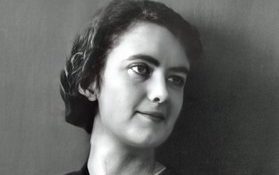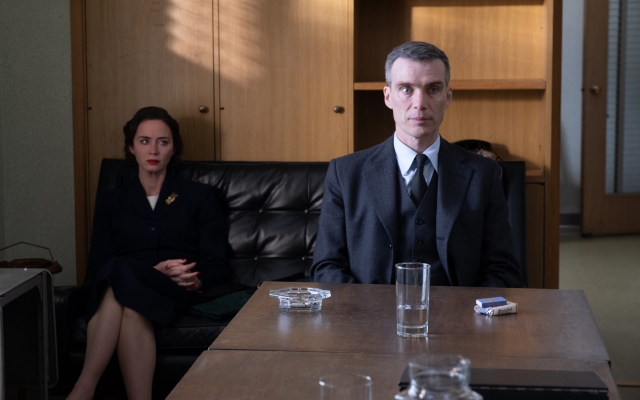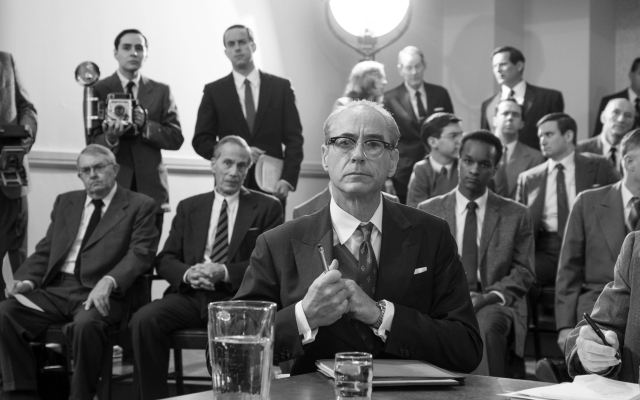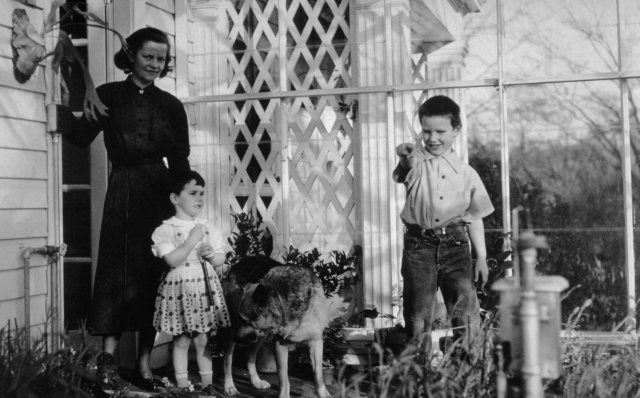 Florence Pugh as Jean Tatlock and Cillian Murphy as Oppenheimer. Author: Universal Pictures. The elements are standard for tales of hard-to-understand geniuses: arrogant, aloof, smug, stubborn. Perhaps more surprising to the father of the atomic bomb is the «womanizer», as J. Robert Oppenheimer (Cillian Murphy) was once bluntly called.
Florence Pugh as Jean Tatlock and Cillian Murphy as Oppenheimer. Author: Universal Pictures. The elements are standard for tales of hard-to-understand geniuses: arrogant, aloof, smug, stubborn. Perhaps more surprising to the father of the atomic bomb is the «womanizer», as J. Robert Oppenheimer (Cillian Murphy) was once bluntly called.
To be sure, the biography on which Nolan's film is based — Kai Bird and Martin J. Sherwin's American Prometheus — describes how the physicist once had half a dozen mistresses on the go. Oppenheimer also had a lengthy affair with a psychologist friend, Dr. Ruth Tolman, and was accused of endangering national security over one ill-advised affair.
The film tells the story of the nuclear weapons supplied by Oppenheimer as part of the Manhattan Project and the 1954 security hearings that served to discredit Oppenheimer by questioning his loyalty, political views, and ties to the Communists. But fueled by sexual exploits, Nolan's film is also unexpectedly raunchy, portrayed by Florence Pugh as Jean Tatlock, a ball of unbridled, seething sultryness (I haven't counted the minutes, but I'll bet my uranium supply that Pugh spends half her screen time naked).
Was J. Robert Oppenheimer really a womanizer? Or did Nolan add a few helpings of sauce? For Raymond Monk, whose own biography of Oppenheimer, Life Inside the Center, was published in 2012, the word «womanizer» is too big a word, although there have been romances, as well as some unrequited affections. “He was very popular with women,” says Monk. “He was very good-looking and could be charming … From the recollections of his secretaries, it is clear that they were all in love with him. Although, as far as I know, he did not try to seduce them.
As seen in the biopic, two women in particular have influenced his life: troubled psychiatrist Jean Tatlock (Pugh) and his also troubled nerd wife Kitty (Emily Blunt).

Oppenheimer first met Jean Tatlock in 1936 at a fundraising party for Republican supporters during the Spanish Civil War. Tatlock, the daughter of a Harvard professor, was then a 22-year-old medical student. “A free-spirited woman with a hungry, poetic mind,” Bird and Sherwin wrote, “she was always the only person in the room, whatever the circumstances, who remained unforgettable.” Tatlock was striking, fiercely intelligent and prone to bouts of darkness. She was also a paid member of the Communist Party. Tatlock's Communist connections—or rather, Oppenheimer's connection to her, and one incident in particular—provided Oppenheimer some trouble later, when he was called to a security hearing in 1954.
Tatlock is sometimes said to have radicalized Oppenheimer, but Monk says this is an exaggeration. It was his students at Berkeley, who were forced to take low-paying jobs after the Great Depression, who opened his eyes to politics. «Oppenheimer's closeness to his students attracted him to the left,» he says. «They were radicalized by the economic conditions of the early 1930s.»
As the film shows, Oppenheimer was already interested in leftist causes by the time he met Jean Tatlock. In the film, Tetlock is portrayed as strong-willed and persuasive—a more ardent communist than she really was. The real Jean Tetlock was not ideologically committed. A psychiatrist by training, she was interested in Freud's psychoanalysis — too bourgeois for hardened commies.
 'She was the love of his life': Gene Tatlock
'She was the love of his life': Gene Tatlock
Oppenheimer later said that her membership in the Communist Party was «an accident again and again, and never seemed to get her what she was looking for.» But Tatlock set fire to Oppenheimer politically; she was more committed to left-wing causes such as republican Spain than to parties, and persuaded Oppenheimer to be more active. «Don't settle for anything,» she said.
Also, there was more to the relationship than politics. “I think the political connection between them was important,” says Monk. “But no less important was their shared love of poetry. They were both lovers of the poetry of John Donne.» Oppenheimer later named the first atomic bomb test «Trinity», apparently inspired by Donne's lines, including «Break my heart, three-person God». “For him, John Donne will always be associated with Jean Tetlock,” says Monk. «I think the name Trinity was as much a tribute to Jean as anything else.»
Their relationship, as Nolan portrayed it, was tense. Tatlock Pew puts into his mouth the famous words: «I became Death, the destroyer of worlds.» Oppenheimer later recalled how these words, taken from the Sanskrit scripture, the Bhagavad Gita, came to him during the Trinity bomb test. In the film, Tetlock forces him to speak the words in the throes of passion — years before the atomic bomb is concocted — which is tantamount to a sweaty merging of sex and looming destruction.
Pugh's turn is relatively short throughout the three-hour run, but it reflects the impact Tetlock had on Oppenheimer. “There is reason to say that she was the biggest love of his life,” says Monk. “He was drugged by her. He reportedly came to her house on numerous occasions with flowers to court her. It's also clear that she wasn't as in love with him as he was with her.» Indeed, Tetlock could be cold and touchy. In one instance, recreated by Nolan, Tetlock tossed aside one of his many bouquets of flowers and told his girlfriend, «Tell him to leave, tell him I'm not here.» The castle, played by Florence Pugh, had a torrid romance. Photo: Melinda Sue Gordon/Universal Pictures
In the three years they were together, Oppenheimer proposed to her twice; twice she refused him. In the film, it is Oppenheimer who ends the relationship after meeting his future wife Katherine «Kitty» Harrison. Oppenheimer tells Kitty that Tatlock loves him «sometimes…not enough». Jin's coldness pushes him into Kitty's arms. In fact, it was Tetlock who broke with Oppenheimer. Although, perhaps, she led him to Kitty in a roundabout way. According to Byrd and Sherwin, Oppenheimer was recovering. He dated many young women and «broke a few hearts». He met Kitty in August 1939 at a party hosted by physicist Charles Lauristin. “I fell in love with Robert that day,” Kitty admitted, “but I hoped to hide it.”
Born Katherine Puening, Kitty was from the German aristocracy on her mother's side. They were associated with various European royalty, including, she claimed, Queen Victoria. Moving to Pittsburgh as a child, Kitty grew up rich. As a child, she was rebellious, bohemian and impulsive. Like Tatlock, she was a member of the Communist Party. Kitty's second husband, Joe Dallet, was a communist and trade unionist; he was killed fighting as a volunteer during the Spanish Civil War. By the time she met Oppenheimer, Kitty was married to an elderly doctor named Richard Harrison. The couple was unhappy — the marriage was only in words. Oppenheimer and Kitty started what was essentially an open affair. The following year, Oppenheimer called Harrison and told him that his wife was pregnant. Harrison quite amicably agreed to a divorce.
As Byrd and Sherwin described, some friends assumed that Oppenheimer would make peace with Tatlock and were concerned when he married Kitty. «Oh, let's face it,» said one friend. «It might be scandalous, but at least Kitty humanized him.» Others were less generous; Kitty, according to Monk, was remembered as «difficult». Oppenheimer's sister-in-law, Jackie, called Kitty «bitch», «schemer» and «fake». Physicist Abraham Pais called Kitty «the most contemptible woman I have ever known». Tatlock and Kitty are at opposite ends of the spectrum of influence in Oppenheimer's life, but they were equally restless souls. Kitty, as seen in the film, was drunk and struggled to bond with her two children, Peter and Tony. They left baby Peter to friends for two months, and Tony was offered for adoption by other friends. Abraham Pais said that the Oppenheimers' family life was «hell on earth.»
 Bitter and unhappy: Emily Blunt as Kitty Oppenheimer Photo: Melinda Sue Gordon/Universal Pictures
Bitter and unhappy: Emily Blunt as Kitty Oppenheimer Photo: Melinda Sue Gordon/Universal Pictures
“It was a bitterly unhappy marriage,” says Monk. “When he moved to Princeton, where he ran the Institute for Advanced Study, everyone hated Kitty for being so difficult. She will be drunk in the afternoon. She was not a pleasant drunk—she was a belligerent, aggressive drunk. People used to be afraid to go to the Oppenheimer house because the relationship between them was so bad.”
The film sidelines Kitty for most of its runtime, apparently in the way male-oriented films do. When Oppenheimer transfers them to Los Alamos, New Mexico, home of the secret base where they developed the bomb, Kitty Emily Blunt becomes a housewife, drinking, complaining about the kitchen, and hanging up the laundry.
However, it rings true, Monk says. “I think Kitty hated being at Los Alamos. Oppenheimer worked all the time. The job made great demands on him. He looked like a skeleton. He looked at least 10 years older than he was. He smoked and drank a lot. She drank even more … she suddenly went shopping in Santa Fe or Albuquerque and disappeared for several weeks.
From 1939 to 1943, Oppenheimer saw Jean Tetlock about twice a year, sometimes at social events, sometimes visiting her. “When we saw each other, we still had a very deep feeling,” Oppenheimer later said. Tatlock asked him to visit her before leaving for Los Alamos in early 1943, but he did not. When asked during a security hearing in 1954 why she wanted to see him, Oppenheimer replied, «Because she still loved me.» This line is repeated in the film.
In June 1943 he visited Tatlock in San Francisco and they spent the night together. He was followed by military intelligence, who reported the connection to the FBI. Oppenheimer's flirtation with a prominent member of the Communist Party, who may well have been (but was not) a Soviet spy, caused some alarm. The head of counterintelligence, Colonel Boris Pash (who threatened Casey Affleck in the film), recommended that Oppenheimer be denied access to the security service and fired. «It wasn't good practice,» Oppenheimer admitted of visiting Tatlock.
 Oppenheimer was subjected to a congressional hearing about his relationship with Jean Tatlock. Photo: Melinda Sue Gordon/Universal Pictures
Oppenheimer was subjected to a congressional hearing about his relationship with Jean Tatlock. Photo: Melinda Sue Gordon/Universal Pictures
“He must have known that security agents would follow him everywhere,” says Monk. “He knew the FBI and Army Security were interested in him. He must have known that he couldn't do anything without the knowledge of the security services, and that's why they would follow him when he went to San Francisco to meet Jean. They would have known that Jean was a member of the Communist Party. Thus, the director of the most secret weapons laboratory in the United States of America spent the night with a well-known member of the Communist Party. It's an incredible thing.» So why did he do it? «I think the only thing that explains it is that he was still in love with Jean Tetlock,» says Monk.
The meeting in San Francisco is featured in the film, after which Cillian Murphy's Oppenheimer cuts it off for good. This is implied to push her over the edge.
Tatlock, at that time a child psychiatrist, suffered from bouts of depression. During their relationship, her dark charms also drove Oppenheimer into depression. In January 1944, Tatlock's father found her dead, drowned in a bathtub. “Everything disgusts me,” her suicide note said. «At least I could take the burden of a paralyzed soul from a struggling world.» She was only 29 years old.
«Oppenheimer was described as 'turned white' when told of her suicide,» says Monk. «I think it was devastating for him because she was the great love of his life.» Monk adds, «It's a guess, but I think it would have affected his relationship with Kitty, which was never good, especially at Los Alamos. It was in Los Alamos that he learned of Jean's death. I think that would be another nail in the coffin of their relationship.”
Nolan's film dramatizes the moment when Oppenheimer learns of Tatlock's death, at which point he confesses to Kitty about their night together. It is unclear when Kitty first learned about this affair in real life; It probably happened at a security hearing in 1954 when Oppenheimer was interrogated about Tatlock and, rather humiliatingly, forced to confess. “Was Kitty aware of this for the first time…I suspect so,” says Monk. “She would be furious. Kitty had character.»
 Aside: Kitty Oppenheimer with children, Katherine and Peter. Photo: CORBIS/Corbis via Getty Images
Aside: Kitty Oppenheimer with children, Katherine and Peter. Photo: CORBIS/Corbis via Getty Images
Although Kitty is sidelined most of the time, Kitty's moment comes in the final act, which focuses on the politics of the security hearings and Oppenheimer's moral struggle with the use of nuclear weapons. In the tradition of Nolan's thematically rich screenplays, Kitty becomes the cynicism of Oppenheimer's naivety, ready to say out loud what Oppenheimer won't say. «Did you think that if you let them smear you with tar and feathers, the world would forgive you?» she asks. «They will not». “I think it rings true,” says Monk. As seen in the film, Kitty also spoke at the security hearing when asked about her former communist connections. «Kitty didn't give up an inch,» Byrd and Sherwin wrote. «Calm and at the same time attentive to every nuance, she was undoubtedly a better witness than the husband she defended.»
J. Robert Oppenheimer died of throat cancer in 1967. Kitty was then living with Bob Serber, one of the friends who always liked her. Kitty died of an embolism in 1972 at the age of 62.
This enormous power, saved for the final act and using Kitty's real answers, is engraved «Best Supporting Actress» throughout. It also speaks to Oppenheimer's original appeal. “Oppie was not a womanizer,” Bird and Sherwin wrote. “But he was the kind of man who was strongly attracted to women who were attracted to himself. Kitty was irresistible.”


























































Свежие комментарии